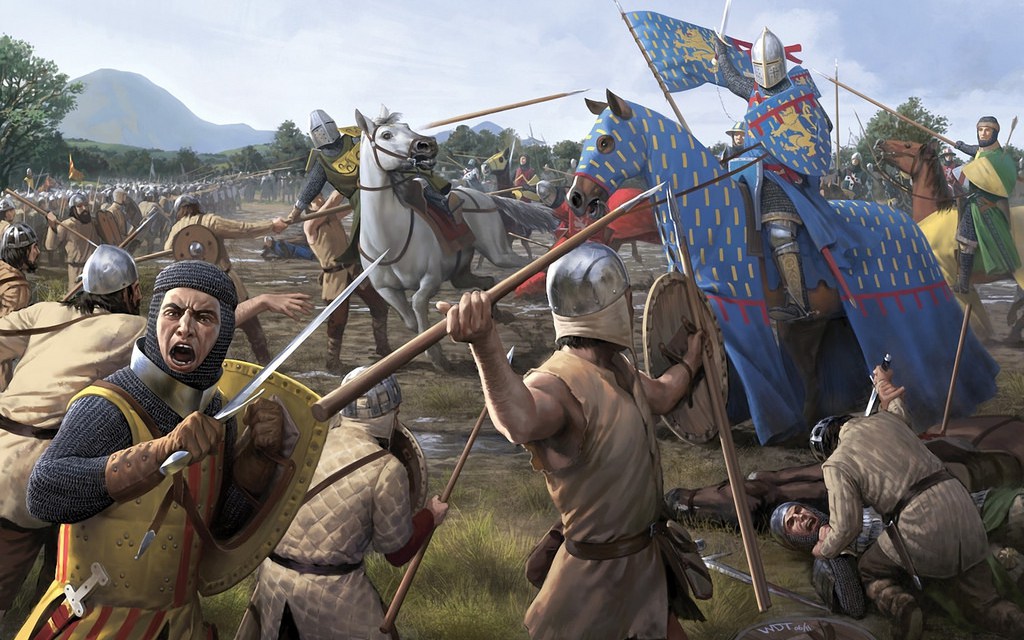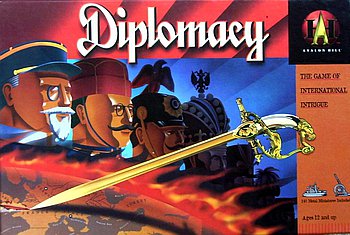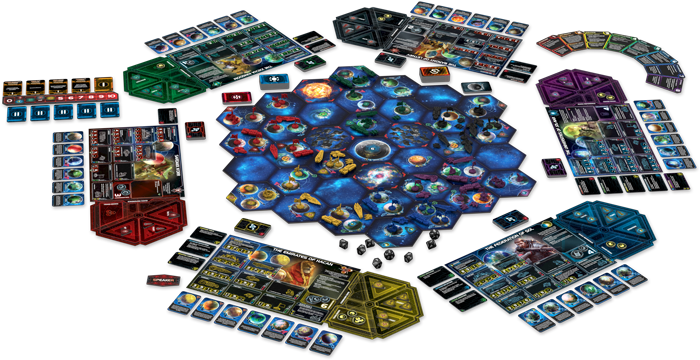Determinacy [di-ˈtər-mə-nə-sē] (Noun)
1: the quality or state of being determinate (1: having defined limits).
Indeterminacy [in-di-ˈtər-mə-nə-sē] (Noun)
1: the quality or state of being indeterminate (1b: not known in advance).
Again, I choose my definitions carefully, for there is a specific reason I selected these two words rather than use the much easier, but much more loaded terms, Luck and Skill.
Determinacy, in game aesthetics terms, refers to the ability to determine a game’s outcome through well defined actions with equally well defined results. In Chess, a piece that ends its move within the diagonal attack pattern of a pawn, can be taken by the pawn, regardless of the victim’s rank. There is no chance for the pawn to fail in its assault, even if attacking a mounted knight who, historically, had massive advantage over the hapless peasant.
 Likewise, any move made by any piece on the board has a definite result, and can lead to a chain of events with clearly understood parameters and outcomes. There is no random chance in Chess, and the only thing standing between victory and defeat is how many moves the player can think ahead. It is totally Determinate.
Likewise, any move made by any piece on the board has a definite result, and can lead to a chain of events with clearly understood parameters and outcomes. There is no random chance in Chess, and the only thing standing between victory and defeat is how many moves the player can think ahead. It is totally Determinate.
Does this mean that every game of Chess is totally predictable? No. The vast combination of board states make it virtually impossible us to predict any game’s end result, outside of saying Bobby Fischer would hand me my butt even on his worst day. But wouldn’t this unpredictability make it indeterminate?
Let’s use OGRE as another example. As with most wargames, there are good, basic strategies that allow the veteran players to whup up on newbies with some frequency. But even the Kasparov of OGRE can lose against a beginner, because with each attack, dice enter into the equation. While the law of averages rewards the experienced over time, the outliers can also screw them over mercilessly at any particular moment.
 Take infantry vs. an OGRE. By all accounts, they are dead meat, and they’ll be lucky to take a single weapon or some treads with them before they are reduced to a whiff of hydrogen, ozone and carbon monoxide. But it is entirely possible that, in the right circumstances, with bad dice rolls on the OGRE’s part, and great dice rolls on theirs, they could kill the thing. Highly (highly) unlikely, but possible.
Take infantry vs. an OGRE. By all accounts, they are dead meat, and they’ll be lucky to take a single weapon or some treads with them before they are reduced to a whiff of hydrogen, ozone and carbon monoxide. But it is entirely possible that, in the right circumstances, with bad dice rolls on the OGRE’s part, and great dice rolls on theirs, they could kill the thing. Highly (highly) unlikely, but possible.
The difference between Chess and OGRE? A loss in Chess is caused by missing an important, but predictable move, like placing your knight in the path of a pawn. A loss in OGRE, however, can come down to a really bad day with the dice, no matter how well you think ahead. This is what we mean by Determinacy and Indeterminacy: the amount by which random chance affects the end result of the game.
THE HUMAN FACTOR
Before we go any further let’s just go ahead and address the 200 pound hairless gorilla in the room: those pesky, unpredictable humans. Even in Chess, the unpredictability of human opponents can often throw a monkey-wrench into the best laid plans, and most well-thought out strategies. This is why it is so much more interesting to play another person instead of a computer. Get eight humans around a table playing a game like Twilight Imperium, and the potential for chaos grows exponentially.
So doesn’t this mean that all games that involve 2 or more people are essentially Indeterminate?
I say no, and for a few reasons:
 N-Player games which lack true random elements tend to place an emphasis on equilibrium and restricted choice that creates predictable results, even when taking into account human behavior (ex. The Prisoner’s Dilemma, Chess, Tic-Tac-Toe).
N-Player games which lack true random elements tend to place an emphasis on equilibrium and restricted choice that creates predictable results, even when taking into account human behavior (ex. The Prisoner’s Dilemma, Chess, Tic-Tac-Toe).- Not all N-Player games are competitive (although, as a rule, cooperative games tend to have at least one random element).
- Most importantly, this theory of Game Aesthetics is focused on the nature of the game mechanics, not that of the participants, be they human, computer or other.
WHY NOT SKILL VS. LUCK?
Because they’re loaded terms, with positive and negative connotations. To say that Chess is about skill, and OGRE is about luck is to sell OGRE short, as in the minds of many, that places it in the same category as Fluxx, or even Candyland. It is also inaccurate. OGRE does involve skill and, as mentioned, on average, the skilled player will trounce the unskilled player. But in the end that is not a certainty, i.e. the result is Indeterminate, because the Combat Results Table allows for at least a 16% possibility to destroy anything on one end, and a 16% chance for minimal effect on the target on the other, no matter what the attack to defense ratio. So let’s just call it that, instead.
Likewise, Tic-Tac-Toe is all skill. There is no randomness. But few (if anyone) would claim it to be a superior game to OGRE, in any way, shape or fashion. Better to say that it is Determinant.
DETERMINACY 3: DIPLOMACY
 Again, I’m using games at the far ends and middle of the scale as examples, and the best example of a Determinacy 3 game that I can think of is a personal favorite of mine: Diplomacy.
Again, I’m using games at the far ends and middle of the scale as examples, and the best example of a Determinacy 3 game that I can think of is a personal favorite of mine: Diplomacy.
In Diplomacy, all pieces, whether army or fleet, are equal in strength, and there is no random element to give one advantage over the other, i.e. you don’t roll dice to see who wins in a struggle, as is typical with the standard wargame. If two forces meet, they push, unless one force has superior support from armies or fleets adjacent to the contested territory. And the way you gain that support is superior planning and, as the name suggests, diplomacy: making alliances with other players (and then, later, taking advantage of them).
Everything about the game is Determinant. You negotiate with other players, give orders to your units, and moves are resolved based upon a well defined set of interaction rules. No random chance enters the equation at any point in the game (unless you count randomly determining who plays which world power during set-up). You can even blunt the inherent unpredictability of human interaction (which, again, is not actually a factor in considering the Aesthetic qualities of a game) by shoring up your defenses and realizing that, to win, one must not only ally but betray, as well, and that this goes both ways. What comes around, goes around, especially if you’re clearly in the lead.
It is this Determinacy that made Diplomacy (like Chess) popular across the world, as a play-by-mail game in the 60’s and 70’s, and as an online game today.
DET♎IND: TWILIGHT IMPERIUM
 As a rule, most wargames fall somewhere around the middle of our scale, dipping into Determinacy 1 in some cases (like Free Kriegsspeil or Wings of Glory), and Indeterminacy 1 in others (like Viktory II or Federation Commander), and a similar number in between, with an equilibrium between determinant and indeterminant elements. This is largely due to the heavy influence non-random mechanics (like maneuver, position and combined arms tactics) exert over the results of random elements (like attack and morale rolls) in these sorts of games.
As a rule, most wargames fall somewhere around the middle of our scale, dipping into Determinacy 1 in some cases (like Free Kriegsspeil or Wings of Glory), and Indeterminacy 1 in others (like Viktory II or Federation Commander), and a similar number in between, with an equilibrium between determinant and indeterminant elements. This is largely due to the heavy influence non-random mechanics (like maneuver, position and combined arms tactics) exert over the results of random elements (like attack and morale rolls) in these sorts of games.
Twilight Imperium is the wargamer’s wargame. It has everything one would expect from a game of intergalactic power struggles, including trade, politics, empire building and, of course, combat. One of the ways Twilight Imperium manges to create equilibrium between determinant and indeterminant elements, is by giving the players many different paths towards victory, including several that do not involve combat (the most indeterminant element in the game).
Like Diplomacy, a players ability to wheel and deal drives a large portion of the game. Unlike Diplomacy, there is no guarantee that an unlucky battle, untimely political agenda card, or even the placement of random tiles at the beginning of the game, won’t scupper your plans. However, unless one is near the endgame, these little setbacks will rarely cost you the game outright, as a host of other decisions and mechanical systems tend to keep their overall knock-on effects in check (unless the player plays over-aggressively or stupidly).
Twilight Imperium is a good example of a game with enough ‘moving parts’ that it can, at times, seem very chaotic and random. But as with Star Fleet Battles, familiarity breeds competency (mostly), which means that the veteran player is much less vulnerable to the vagaries of chance. The balance of systems ensures, however, that even a first time player has a nice sized ‘buffer’ that will keep them in the game long enough to learn their way around, and possibly even win.
INDETERMINACY 3: CRAPS

“Hey, Blaise, buddy! How about you help me part more fools from their money?” Antoine Gombaud. Probably.
One of the oldest forms of gaming and gambling involves chucking dice. As a matter of fact, Blaise Pascal laid the foundations of Probability Theory while trying to figure out a problem involving dice for his friend Antoine Gombaud, AKA the Chevalier de Mere. Gombaud was an inveterate gambler looking to invent a new dice game that would give him an advantage that wouldn’t be readily obvious to his opponents (i.e. screw them over with math).
These days, we have Craps. Now, there are folks that say there is some skill involved in Craps, and in the spirit of our friends Pascal and Gombaud, those with a steady grasp of the game’s statistics can win more often than they lose. As with OGRE, the dice don’t always cooperate, but unlike OGRE, there is nothing one can do to really shift the odds in their favor. You can’t add or subtract dice, modify the numbers, throw the dice a certain way, nothing. You just throw the dice and hope they land the right way.
Your only real options are to keep rolling or pass the dice, and determine where to place your bet, and the results of those decisions are entirely dependent on chance. So Craps is the perfect example of an Indeterminate game.
COMING NEXT…
Next we will discuss how much room a player has to affect the endgame, as we investigate Agency vs. Linearity.




Pingback: GAME AESTHETICS: INTRODUCTION… |